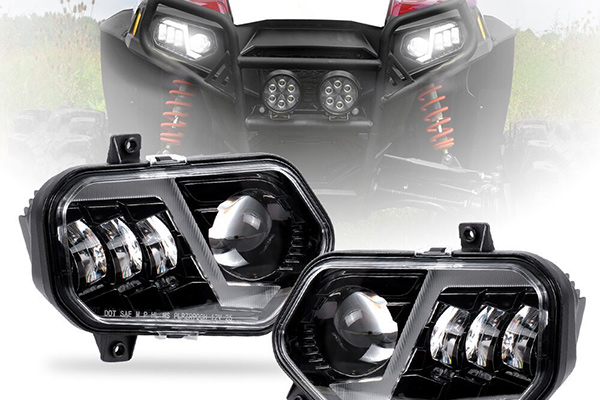When it comes to off-roading after sunset, a reliable lighting system is crucial for safety and performance. The Polaris RZR 800 comes with a factory lighting setup that works for casual riding but has notable limitations for serious night-time trail adventures. In this article, we’ll break down the stock lighting system, its performance in real-world conditions, and why many riders choose to upgrade.
Stock Lighting Overview

The Polaris RZR 800 comes equipped with a basic but functional lighting package straight from the factory. Here’s what you get:
- Dual Halogen Headlights – The primary forward-facing lights provide decent illumination for slow-speed trail riding but lack the brightness and range of modern Polaris RZR LED headlights alternatives.
- Taillights & Brake Lights – Standard incandescent bulbs that meet DOT requirements but aren’t exceptionally bright, especially in dusty or foggy conditions.
- Basic Wiring Harness – Designed to handle the stock lighting load but may require upgrades for additional aftermarket lights.
While this setup is sufficient for daytime riding and short night trips, riders who frequently explore dark trails or rugged terrain often find the stock lighting underwhelming.
Performance Limitations
1. Dim & Narrow Beam Spread
The biggest drawback of the stock halogen headlights is their limited brightness and beam distance. Unlike modern LED or HID lights, halogens produce a yellowish, diffused glow that doesn’t penetrate far enough for high-speed night riding.
- Short Illumination Range – Stock lights illuminate about 50-75 feet ahead, which can be dangerous when navigating rocky or uneven terrain at speed.
- Poor Peripheral Vision – The beam pattern is narrow, leaving dark spots on the sides where obstacles (like trees or drop-offs) may be hidden.
2. Power Drain & Heat Issues
Halogen bulbs consume more power and generate significant heat compared to LEDs. This can lead to:
- Battery Strain – Adding extra accessories (like winches or sound systems) without upgrading the electrical system can cause voltage drops.
- Bulb Burnout – Halogens have a shorter lifespan, especially when subjected to heavy vibration from off-roading.
3. Weak Taillight Visibility
The stock incandescent taillights are adequate for normal conditions but can be hard to see in:
- Dusty trails (common in desert or group riding)
- Heavy rain or fog
- Low-light dusk/dawn conditions
Many riders upgrade to LED taillights or add additional brake light strips for better visibility.
Common Upgrades for Better Lighting
Since the stock lighting system has clear limitations, most serious off-roaders invest in upgrades. Here are the most popular modifications:
1. LED Headlight Replacement
- Brighter & Whiter Light – LEDs provide 3x the visibility of halogens with a crisp, daylight-like beam.
- Lower Power Consumption – Reduces strain on the electrical system.
- Longer Lifespan – No filaments to burn out, making them more durable.
(Popular brands: Rigid Industries, KC HiLiTES, Oracle Lighting)
2. LED Light Bars & Pods
- Single/Dual Row Light Bars – Mounted on the roof or bumper for wide, long-distance illumination.
- Spot & Flood Combos – Adjustable beam patterns for different trail conditions.
- Ditch Lights – Side-mounted pods to eliminate blind spots.
3. Rock Lights & Underbody Lighting
- Helps with low-light visibility under the vehicle (useful for rock crawling).
- Adds a custom look with RGB options.
4. Upgraded Taillights & Brake Lights
- LED Taillight Kits – Brighter and more responsive than stock.
- Third Brake Light Add-ons – Improves visibility in group rides.
5. Wiring & Switch Panel Upgrades
- Heavy-Duty Harness – Supports additional lighting without overloading the system.
- Relay-Controlled Switches – Prevents flickering and voltage drops.
Is the Stock Lighting System Good Enough?
For casual riders who stick to well-lit trails or only occasionally ride at night, the stock lighting may suffice. However, for those who frequently tackle dark, technical terrain or ride in groups where visibility is critical, upgrading is highly recommended.
Pros of Stock Lighting:
✔ Simple & DOT-compliant (legal for road use where applicable)
✔ No additional cost or installation required
✔ Adequate for slow-speed, short-distance night rides
Cons of Stock Lighting:
❌ Insufficient brightness for high-speed off-roading
❌ Narrow beam pattern creates blind spots
❌ Halogen bulbs burn out faster than LEDs
❌ Not ideal for extreme conditions (dust, fog, heavy rain)
Upgrade for Serious Night Riding
While the Polaris RZR 800’s stock lighting system meets basic needs, it falls short for enthusiasts who demand better visibility and durability. Fortunately, the aftermarket offers plenty of affordable, high-performance lighting upgrades that can transform your RZR into a night-riding beast.
If you’re serious about off-roading after dark, investing in LED headlights, light bars, and auxiliary pods will drastically improve safety, performance, and overall riding experience.
